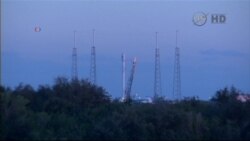A new satellite is on a 1.5 million-kilometer, 110-day journey toward the sun. Once it reaches its orbit, DSCOVR — the Deep Space Climate Observatory — will replace an aging craft to monitor space weather.
DSCOVR will be fixed in orbit at L1, the so-called Lagrange point where the gravitational pull of the sun and of Earth cancel each other out. From this distant outpost, it will document the continuous stream of charged solar particles.
Life on Earth is mostly protected from those particles by the planet’s magnetic field and atmosphere. But Thomas Berger, director of the National Oceanic and Atmospheric Administration's Space Weather Prediction Center in Boulder, Colorado, said large-scale eruptions from the sun, called coronal mass ejections, can still be dangerous.
“Those are really, really large magnetic clouds that are expelled from the sun at very, very high speeds … and when those impact the Earth, that’s like a tsunami or a hurricane impacting the Earth in terms of space weather," he said.
Violent space weather can disable electric power grids, knock out satellites, and interrupt radio signals and aviation communications systems. This year marks the peak of the 11-year solar cycle, when extreme weather on the sun can most affect life on Earth.
Berger said full recovery from a really bad solar storm could take four to 10 years and cost between $1 trillion and $2 trillion, according to a recent report published by the National Research Council.
“There really is not much we can do about it, given that the sun is a gigantic star and we are just a tiny little planet in its orbit. However," he pointed out, "NOAA’s job and the Space Weather Prediction Center’s job in particular is to predict these phenomena and give people the watches, warnings and alerts that they need to take mitigation action.”
A step ahead of the storm
DSCOVR will sit like a buoy in space. It will do the same job as NASA’s 17-year old Advanced Composition Explorer (ACE), which has worked long beyond its design life.
DSCOVR will ensure there is no gap in real-time solar observations. Berger said the satellite data will provide 15 to 60 minutes of advanced warning to managers on the ground.
“Fifteen to 60 minutes is enough time for power grid operators to take mitigation actions, such as spooling up other generators to balance loads,” he explained. “It’s enough time for satellite operators to take their satellites into safe mode if necessary. So, it’s enough time."
But space weather forecasters want more. Berger said projects are in the works to extend those alerts. “It would be great if we even had something even farther towards the sun, and that’s possible using perhaps solar sail technologies in the future, but right now what we can do is put something in that gravitational sweet spot and leave it there. That’s the DSCOVR satellite.”
ACE will stay in service
DSCOVR, like ACE, will issue planetary scale predictions and warnings. NOAA plans to use ACE data, too, as long as the aging satellite survives.
“We can tell you something is coming in,” Berger said. “However, with the ACE in the future and the upcoming models we’re developing, we’ll be able to tell you which regions of the Earth will be more or less susceptible to these incoming solar storms.” This will mean that for the first time, warnings will advise not only that a magnetic storm is heading toward Earth, but where it will strike.
DSCOVR also carries two NASA Earth-observing instruments that will gather a range of aerosol and ozone measurements for other science work. NOAA will operate the satellite and process the data. The mission is a joint partnership between NOAA, NASA and the U.S. Air Force.








